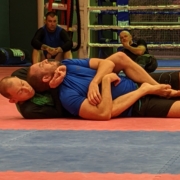Rolling as a coach: Intermediate
The first thing a beginner needs to learn is not technical skill itself, but rather how to train to gain that technical skill. This is an important yet subtle point. Technical instruction alone, no matter how detailed, is not enough to ensure someone progresses quickly. The previous post described the methods I use to get a beginner to the point where they can train effectively.
Beginners only needs a few weeks to learn how to train. Once they understand this they move into the intermediate stage of training and are ready to start perfecting their technical skill. The main technique I use to train someone at this intermediate level is shaping.
Before discussing shaping, let’s understand the difference between drilling and rolling for an intermediate student. Drilling allows a student to learn a particular technique or skill in isolation. Good drilling always involves progressive resistance. When rolling, a student must integrate these new skills into their game. The challenge for someone at the intermediate level is how to transfer the skills that they successfully demonstrated while drilling, into the chaos and stress of a live roll.
Shaping is a conceptually simple training technique from behavioural psychology. The core idea of shaping is that it takes time to learn something new, and it is unrealistic to expect someone to get everything perfect immediately. The solution is to start by accepting a vague approximation of the desired behaviour as successful. The next time you are a little more strict in what you accept as successful. You become more and more strict with each iteration until the behaviour is perfect.
In a typical roll with an intermediate student, my goal is for them to technically improve one or two of the skills or techniques they are currently using. The mechanism is simple. The student will successfully apply a technique several times during the roll. Each time they attempt the move, it needs to be more technically correct than last time to be successful. I am not teaching them a new move. They are learning to apply something they have already drilled successfully, in a live roll. With enough iterations, the move becomes a technically sound part of their game and it is time for me to work on a different area of their game.
Shaping has long been a mainstay of teaching animals complicated behaviour. The last few years have seen a surge in interest in applying shaping techniques to humans, in particular in the fields of dance and athletics. There is lots of accessible research about shaping, and it is a tool that all trainers should be proficient with.



Leave a Reply
Want to join the discussion?Feel free to contribute!